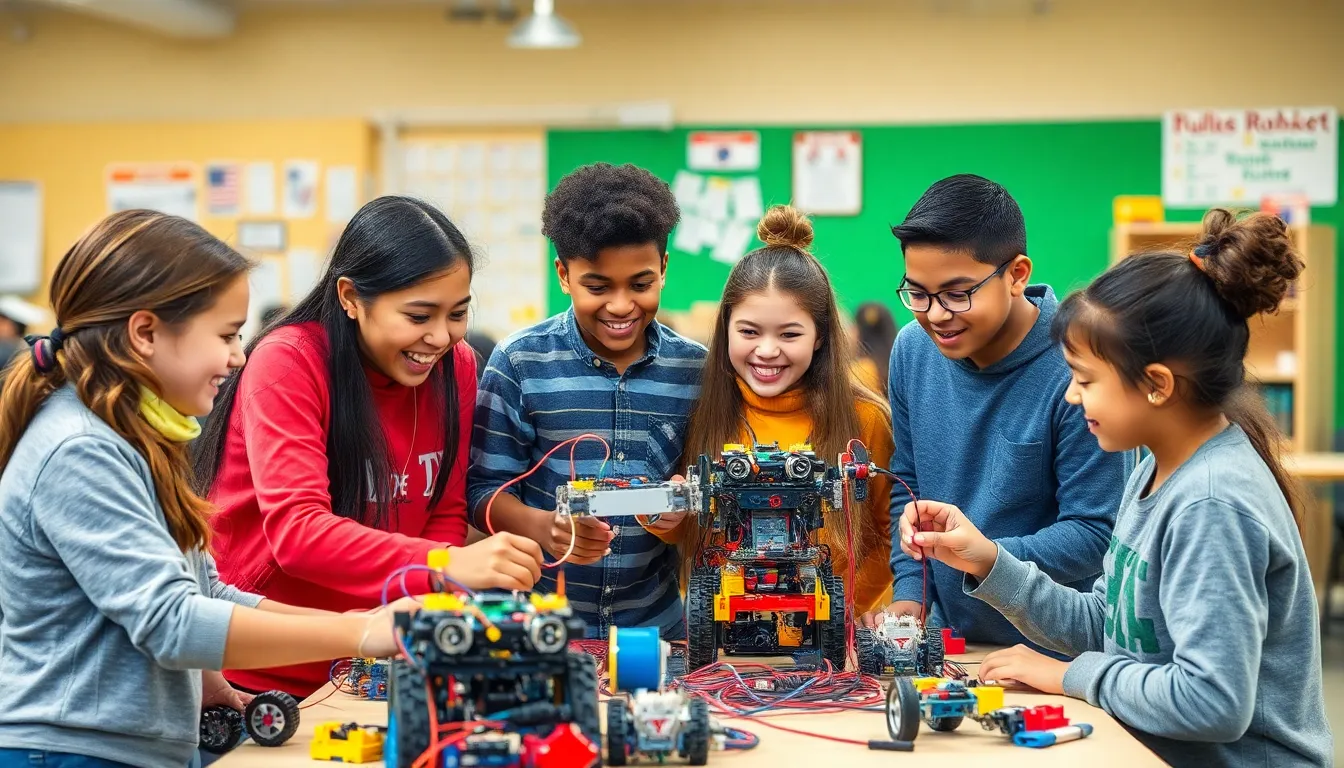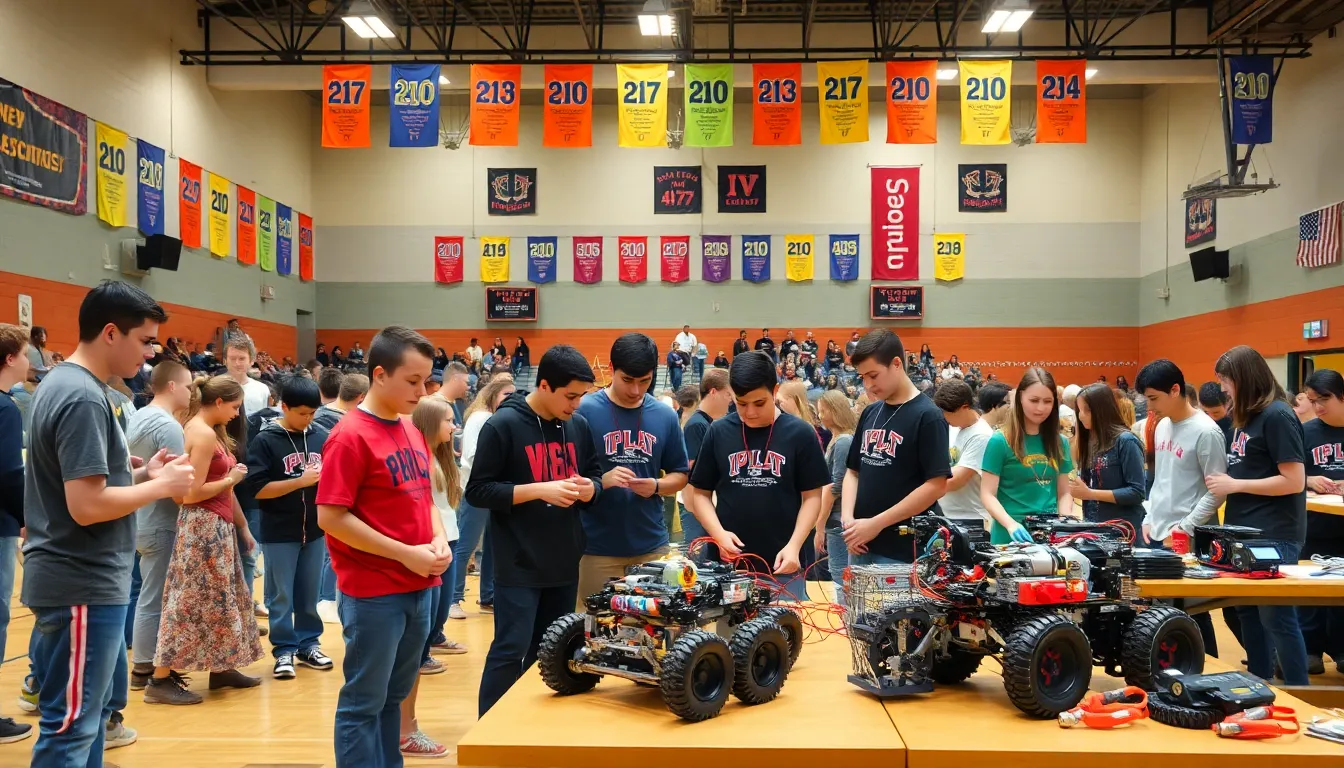In a world where robots are no longer just the stuff of sci-fi movies, FIRST Robotics is leading the charge, turning students into tech-savvy innovators. Imagine a high school gym buzzing with excitement as teams of eager kids design, build, and program their own robots. It’s like a science fair on steroids—minus the actual steroids, of course.
Table of Contents
ToggleOverview of FIRST Robotics
FIRST Robotics engages students in meaningful, hands-on experiences related to technology and engineering. Offering competitions and programs, this initiative fosters creativity and problem-solving skills among its participants. Teams made up of students from various backgrounds collaborate to design, build, and program robots, creating an exciting atmosphere reminiscent of a science fair.
Each year, students face unique challenges that promote critical thinking and teamwork. During these events, participants showcase their robots, demonstrating their skills and creativity. The competition provides an opportunity for personal growth, highlighting essential life skills that extend beyond robotics.
FIRST Robotics emphasizes the importance of mentorship. Educators and industry professionals guide students through the process, offering support and expertise. Such mentorship encourages students to pursue careers in STEM fields, making connections between their educational experiences and future opportunities.
Diverse programs cater to a wide range of ages, starting from elementary to high school students. Initiatives like FIRST LEGO League introduce younger students to robotics concepts, while the FIRST Tech Challenge and FIRST Robotics Competition target high school students seeking deeper challenges. Each program enhances students’ understanding of engineering principles, teamwork, and leadership.
Furthermore, FIRST Robotics fosters a global community. Participants connect with peers worldwide through competitions and online platforms, sharing ideas and experiences. This network not only inspires innovation but also nurtures friendships, building a supportive environment for aspiring engineers and innovators.
History of FIRST Robotics

FIRST Robotics began with the vision of engaging young minds in science and technology through robotics. The initiative emphasizes hands-on experiences, fostering a passion for innovation among students.
Founding Principles
In 1989, FIRST was established by Dean Kamen to inspire students through exciting robotics competitions. Its core values include teamwork, respect, and inclusion, encouraging collaboration among students from various backgrounds. Through projects, participants develop problem-solving skills and creativity, preparing them for STEM careers. Accessibility remains vital, as the organization strives to reach students of all ages, creating opportunities for learning through robotics.
Milestones in Development
Significant growth marked FIRST Robotics since its inception. The introduction of the FIRST Robotics Competition in 1992 transformed high school engagement in robotics, attracting thousands of participants annually. Expansion occurred with the creation of FIRST LEGO League in 1998, targeting younger students. This program emphasizes teamwork and fundamental robotics concepts. In 2005, the FIRST Tech Challenge added another level of competition for middle and high school students, increasing accessibility to robotics challenges. Over the years, FIRST Robotics has gained a global presence, establishing an inclusive community that fosters international collaboration and innovation.
Key Programs and Competitions
FIRST Robotics features several dynamic programs and competitions, each designed to engage students at various educational stages and encourage skills in STEM.
FIRST Robotics Competition (FRC)
The FIRST Robotics Competition caters to high school students, providing a rigorous environment to design and build complex robots. Teams of students work together for six weeks to construct a robot that can complete specific tasks. Events take place in arenas where teams compete for regional, national, and world titles. The experience fosters not only engineering skills but also project management and teamwork. In 2023, over 3,800 teams participated, demonstrating the competition’s expansive reach and impact on youth interest in robotics.
FIRST Tech Challenge (FTC)
The FIRST Tech Challenge serves middle and high school students, promoting creativity and innovation in a less resource-intensive environment than FRC. Participants design, build, and program robots using a variety of materials, including reusable components. Teams of up to 15 students collaborate in a structured format over the season, with competitions focusing on building and coding skills. In 2022, more than 5,000 teams took part, showcasing the growing interest in accessible robotics challenges for diverse skill levels.
FIRST LEGO League (FLL)
The FIRST LEGO League targets elementary and middle school students, offering a playful approach to robotics through LEGO building sets. Teams explore real-world problems by designing robots and solutions to complete challenges on a themed playing field. Engagement in FLL fuels students’ interest in critical thinking and innovation. As of 2023, over 40,000 teams worldwide showcased their projects, reinforcing the program’s role in nurturing young engineers and early problem solvers.
Impact on Education and Community
FIRST Robotics significantly enhances education and community involvement through its dynamic programs. This initiative engages students in STEM, providing hands-on experience that fuels interest in science and technology.
STEM Engagement
FIRST Robotics motivates students to explore STEM fields by combining education with exciting competitions. Programs like FIRST LEGO League allow younger participants to tackle real-world problems using LEGO sets. Through these interactions, students develop a passion for innovation. In 2023, FRC attracted over 3,800 teams, showcasing its broad impact. The competitive environment also encourages collaboration among students from diverse backgrounds, enhancing their understanding of engineering concepts. Engaging in robotics fosters curiosity and creativity, making STEM an exciting avenue for many.
Skills Development
Building robotics skills through FIRST programs prepares students for future challenges. Students enhance problem-solving abilities by designing and programming robots, engaging them in critical thinking. Teamwork plays a crucial role, promoting communication and collaboration among participants. Participants also develop project management skills while working under tight deadlines in competitions. Mentorship from educators and industry professionals boosts personal growth, guiding students in their academic journey. Collectively, these skills create a solid foundation for pursuing careers in STEAM fields.
Challenges and Future of FIRST Robotics
FIRST Robotics faces various challenges that include funding, resource allocation, and accessibility. Many teams struggle to secure adequate sponsorship and grants, limiting their ability to build competitive robots. Geographic disparities also impact participation, as rural areas often lack sufficient support and resources compared to urban regions. This uneven access affects the diversity of teams in competitions, making it essential for FIRST to develop strategies that expand outreach to underserved communities.
Technological advancements present both challenges and opportunities for FIRST Robotics. Rapid changes in technology require teams to stay updated with current trends and tools. Students often encounter difficulties adapting to new programming languages or hardware options. However, embracing these advancements can enhance educational experiences, fostering innovation and creativity among participants.
The future of FIRST Robotics holds great potential for growth and improvement. Expanding programs can introduce robotics to even younger students, planting the seeds of interest in STEM careers early on. Increased focus on artificial intelligence and machine learning can be integrated into competitions, making them more relevant to current industry standards. Networking opportunities for students can expand through partnerships with tech companies, providing mentorship and career pathways.
Developing a more robust online presence will facilitate greater engagement. Virtual competitions and resources can help bridge gaps when in-person events are not possible. With a strong commitment to inclusivity and diversity, FIRST Robotics aims to inspire the next generation of innovators and engineers, ensuring every student has the opportunity to excel in STEM fields.
FIRST Robotics stands as a beacon of innovation and collaboration in education. By engaging students in hands-on robotics experiences, it cultivates essential skills that extend beyond the classroom. The initiative’s commitment to diversity and inclusion ensures that aspiring engineers from all backgrounds can thrive.
As the program evolves, it continues to adapt to the changing technological landscape while addressing challenges in accessibility and funding. The future of FIRST Robotics promises to be bright, with opportunities for further expansion and the integration of cutting-edge technologies. This dynamic environment not only inspires the next generation of STEM leaders but also fosters a global community of passionate individuals ready to tackle real-world challenges.




